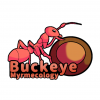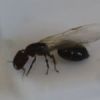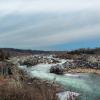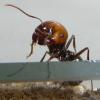To my knowledge, the only arboreal Aphaenogaster in North America are Aphaenogaster mariae, and Aphaenogaster picea is known to be polygynous in some areas.Scientific Name: Aphaenogaster picea
Common Name: Unknown
Distribution: Northeastern, and some Southeastern United states.
Queen size: 7-8mm
Worker size: 4-6mm
Natural Habitat: Found in dead/moist wood in mountainous or rocky habitats of higher elevations.
Circadian Activity: Mostly diurnal, but will forage at night.
Mating Flight: Their major flight is in August after a light rain, and have been known to fly before and after August.
Queen Founding Method: Fully Claustral.
Monogyne or Polygyne: Monogyne
Average time from egg to worker: Egg to larva - 10-15 days; larva to pupa (no cocoon) - 15-20 days; Pupa to worker – 15-20 days. Time may vary with temperature. (Note: can be very slow to start)
Recommended Temperature: 75-80°F (24-27°C)
Recommended Humidity: Mid humidity level of 30-50%.
Preferred Foods: Mainly insects such as termites, fruit flies, crickets, meal worms, and wax worms. This species regularly refuses liquids by covering up any sources. Very little to no activity with feeders.
Hibernation Details: In the wild temperatures below freezing are common, even up to -40C/F. In captivity it is advised to stay above the freezing point as we are unable to easily duplicate the slow cool down into freezing temps to allow the anti-freeze in their blood to work properly. Hibernation is recommended between 39F (4C) - 50F (10C).
Escape Barrier Methods: Extra virgin olive oil works for me.
Difficulty rating: Easy to keep, can be difficult to start.
Bite and/or Sting rating: None
Special Care or Interesting Notes: This species prefers a constantly hydrated nest with dry spots. This species also lacks a social stomach, so foods will have to be carried back to the nest. Aphaenogaster have been recorded making “sponges” to absorb liquids on rare occasions, otherwise liquids are rarely taken.
Description: Aphaenogaster picea is an arboreal species that aids forests and woods in seed dispersal. This species will eat the skin off of seeds and drop the remains, which usually results in the start of a new sapling or plant. Dark red/brown coloration with the last 4 segments of their antennae being lighter in color. workers will have an easily identifiable yellow tipped gaster.
Additional Links:
Information submitted by Loops117
Sent from my Pixel XL using Tapatalk



























